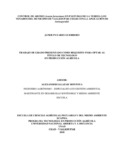Mostrar el registro sencillo del ítem
Control de aromo (Acasia farnesiana) en pasturas de la vereda los Venados del municipio de Valledupar Cesar con la aplicación de Aminopyralid.
| dc.contributor.advisor | Salazar Montoya, Alexander | |
| dc.coverage.spatial | cead_-_valledupar | spa |
| dc.creator | Payares Guerrero, Janer Eugenio | |
| dc.date.accessioned | 2018-11-03T15:37:58Z | |
| dc.date.available | 2018-11-03T15:37:58Z | |
| dc.date.created | 2017-12-23 | |
| dc.identifier.uri | https://repository.unad.edu.co/handle/10596/21185 | |
| dc.description.abstract | Con este proyecto se buscó identificar una posible solución al control de algunas arvenses arbustivas, que poseen dificultad en su control y manejo por costos de mano de obra, labores, cantidad de rebrotes, entre otros. Las pasturas o potreros deben ser tratadas como un cultivo, porque que requieren diferentes labores de manejo como lo son fertilización, control de insectos, enfermedades y arvenses. Las arvenses son catalogadas como plantas no deseadas, ya que estas compiten por agua, luz y nutrientes, que van a disminuir las producciones en este caso de las pasturas, evitando su rápido crecimiento y desarrollo. El Aromo (Acacia fernesiana) es una arvense muy común en los potreros de la costa seca colombiana, es un arvense por características botánicas y fisiológicas, adaptándose bien a este ecosistema, es una arvense agresiva con una alta cobertura en las áreas de pasturas. Sin desconocer que en épocas de verano las vainas del Aromo, son apetecibles por los animales, en invierno se requiere controlar ya que se reproduce muy rápido y les resta espacio a las pasturas para su normal desarrollo y reproducción. Por la dificultad en el control del Aromo, se propuso utilizar el método de toconeo, que es un sistema de aplicación para controlar arvenses arbustivas de raíz. Este sistema consta de la realización de algunos pasos, corte, pique y aplique. El objetivo fue observar la acción de un producto de la línea de los herbicidas cuyo ingrediente activo es (Aminopyralid). Se logró evaluar el porcentaje positivo de rebrotes con la utilización del producto herbicida a base de aminopirali en el manejo de aromo (Acasia farnesiana) arvense agresiva, las cuales están afectando los cultivos de pasto que se encuentran en la finca la Tinajita corregimiento los venados del municipio de Valledupar Cesar, se reducirá el gran número de rebrote de este arvense. Se recalca la necesidad de aplicar esta propuesta, para no dejar tomar ventaja de este arvense en los cultivos de pasto, porque se está ocasionando un gran problema de producción del mismo, el arvense tomará formas mayores y la competencia por agua, luz y nutrientes serán drásticas y perjudiciales en última instancia para el productor. | spa |
| dc.format | spa | |
| dc.format.mimetype | application/pdf | spa |
| dc.language.iso | spa | spa |
| dc.publisher | Universidad Nacional Abierta y a Distancia UNAD | spa |
| dc.title | Control de aromo (Acasia farnesiana) en pasturas de la vereda los Venados del municipio de Valledupar Cesar con la aplicación de Aminopyralid. | spa |
| dc.type | Proyecto aplicado | spa |
| dc.subject.keywords | Tierra de pastoreo | spa |
| dc.subject.keywords | Cultivo | spa |
| dc.subject.keywords | Fertilizante | spa |
| dc.subject.keywords | Herbicida | spa |
| dc.subject.keywords | Control de Maleza | spa |
| dc.description.abstractenglish | A This project seeks to identify a possible solution to the control of some shrubby weeds, which have difficulty in their control and handling costs of labor, labor, and number of sprouts, among others. The pastures or paddocks should be treated as a crop, because they require different management tasks such as fertilization, insect control, diseases and weeds. The weeds are classified as unwanted plants, since they compete for water, light and nutrients, which will decrease the yields in this case of the pastures, avoiding their rapid growth and development. The Aromo (Acacia fernesiana) is a very common arvense in the paddocks of the Colombian dry coast, it is an arvense by botanical and physiological characteristics, adapting well to this ecosystem, it is an aggressive tree with a high coverage in the areas of pastures. Without ignoring that in times of summer the pods of the Aromo, are appetizing for the animals, in winter it is required to control since it reproduces very fast and it reduces space to the pastures for its normal development and reproduction. Due to the difficulty in the control of the Aromo, it is proposed to use the method of toconeo, which is an application system to control arboreal root weeds. This system consists of the realization of some steps, cut, chop and apply. The objective will be to observe the action of a product of the line of herbicides whose active ingredient is (Aminopyralid). By evaluating the positive percentage of sprouts with the use of the herbicide product based on aminopyralid in the management of Aromo (Acasia farnesiana) aggressive, which are affecting the grass crop found in the farm Tinajita corregimiento the deer municipality of Valledupar Cesar, will reduce the large number of regrowth of this arvense. Emphasis is placed on the need to apply this proposal, so as not to take advantage of this crop in pasture crops, because it is causing a major production problem, the harvester will take greater forms and competition for water, light and nutrients will be Drastic and damaging ultimately for the producer. | spa |
| dc.subject.category | Tecnología en Producción Agrícola | spa |
| dc.rights.accesRights | info:eu-repo/semantics/openAccess | spa |
| dc.rights.acceso | Abierto (Texto Completo) | spa |
Ficheros en el ítem
Este ítem aparece en la(s) siguiente(s) colección(ones)
-
Agronomía [574]















